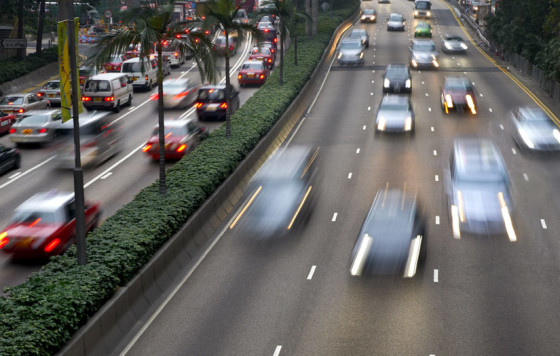The right temperatures and wind conditions can bend highway noise like a prism bends light, thwarting roadside sound barriers and plopping sounds as loud as a vacuum cleaner into the yards of residents more than a quarter of a mile away.
These findings were presented today at a meeting of the Acoustical Society of America, by Nick Ovenden of University College, London. He worked with an Arizona team investigating reports by some Scottsdale, Ariz. residents about a third of a mile from the highway who had complained about loud noise, especially during the early morning and dusk hours.
The team took measurements of sound levels, wind speed and direction up to about 1,000 feet and used this information in models of noise that included the prism-like effects of wind and temperature on sound waves.
"What we managed to show is the combination of the crosswind and the temperature gradient can cause sound that's going to go vertically (to) get refracted back down," he said. "The sound was literally bent back downwards."
The effect often happens at dawn and dusk because sound bends from hotter air into cooler air. During the day, the ground is hotter than the air above it so sound bends vertically upward.
"Its only when the sun stops falling on the ground that the ground cools down. Then the air gets hotter above," he said. "That's when sound can bend towards the ground and become trapped."
Similarly, sound bends toward slower wind speeds, so the right crosswinds can bend sound around barriers.
While Arizona has some extreme temperatures, crosswinds are common and Ovenden predicts the phenomenon will be common elsewhere.
"There wasn't anything particularly special about that day," he said.
The team reported that sound levels at the locations they measured a third of a mile from the highway — which normally have little highway noise the level of quiet rain — were at times above 67 decibels. When traffic noise exceeds this level, on average, for an hour, the U.S. Federal Highway Administration stipulates that some noise abatement must be put in place.
"We didn't suggest that that level was going on for a whole hour," he noted. "We just showed it was possible for it to exceed," he said, if the wind and temperature conditions lasted for more than an hour.
"I think the main point is that if you are planning highways, you really should be taking these meteorological aspects into account," Ovenden said, "at least putting some typical conditions into the model and seeing how bad it could be."
This meteorological effect is not usually used in models of highway noise, agreed Siu Kit Lau of the University of Nebraska-Lincoln.
"You can argue that those sorts of things a noise barrier can't do much about," Ovenden added, speaking of the expensive walls that line the sides of highways to protect the immediate neighbors from the roar of traffic. "That sound has gone maybe 50 or 100 feet up and then it has come back down."
One strategy for turning down the distant din is to stop the noise at its source through quieter engines or road coatings that reduce tire noise.
Lau is exploring a number of strategies for reducing highway noise including barriers with different-shaped edges.
He is also investigating "active noise reduction" for highway noise, based on the same principle as noise-canceling headphones, where a microphone would collect the highway noise and a loudspeaker would broadcast sound waves tuned to cancel it out.
"Barriers are very effective for the high-frequency sound," Lau said. "The active noise control is very good for the low-frequency sound."
